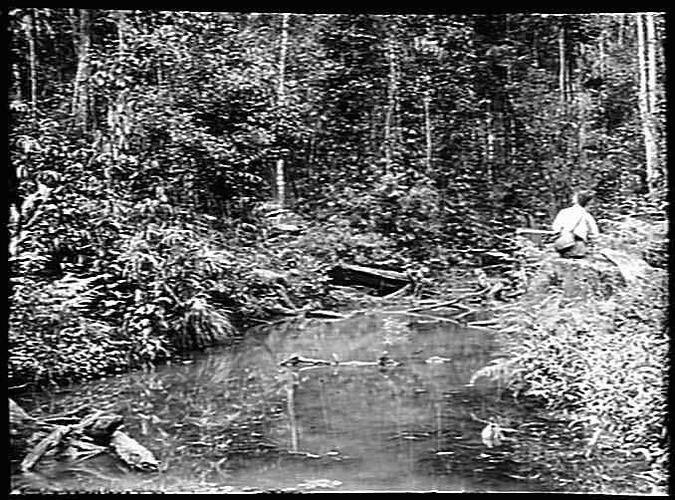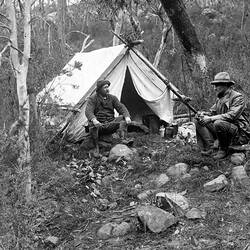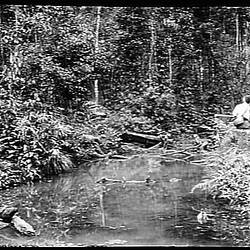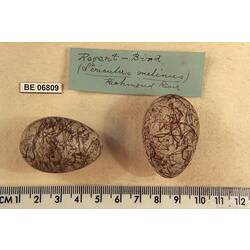REGENT BIRD (Sericulus Melinus, Swainson - 282)
Geographical Distribution - South Queensland and New South Wales.
Nest - Flat, slightly concave; loosely constructed of coarse twigs or dead branchlets, lined on top with fine brownish twigs and yellowish wire-like stems of a climbing plant, the latter being chiefly placed round the side; usually situated in dense scrub, at a height of from twelve to twenty-five feet from the ground. Dimensions over all, 12 inches long by 60 inches broad and 2 inches thick. (See illustration.)
Eggs - Clutch, two, sometimes three. In a clutch of two - (1) is a beautiful, well-shaped specimen, with textures of shell fine and surface slightly glossy; colour, light yellowish-stone, with a faint greenish tinge, marked with blotches and spots of sienna or olive-brown, but chiefly with remarkable hair-like markings of the same colour, as if a person had painted on the shell fanciful shapes and figures with a fine brush. Intermingled are a few dull greyish streaks. All the markings are fairly distributed, being more abundant round the upper quarter; (2) is similar to the other specimen, but markings are less pronounced and finer in character, with a greater proportion of dull greyish, hair-like streaks. Dimensions in inches: (1) 1.57 x 1.2, (2) 1.55 z 1.07. (Plate 10)
A second clutch is similar to the above, but has markings like a network all over, and finer or more hair-like in character. Dimensions in inches: (1) 1.58 x 1.06, (2) 1.52 x 1.04.
The eggs of the Regent Bird resemble, in a remarkable degree, those of the Spotted Bower Bird (Chlamydera maculata), with the slight difference that the ground-colour of the eggs of the former is usually more yellowish in tone.
Observations - The Regent Bird has a somewhat restricted range, being chiefly confined to the sub-tropical coastal scrubs of the northern portion of New South Wales and Southern Queensland; but its extreme southern limit appears to be Port Jackson in the south, where the bird has been occasionally observed, and the Fitzroy River in the north. With regard to the latter locality, Mr. George Potts, jun., Rockhampton, wrote: - 'A few Regent Birds have made their appearance during this month (December, 1895) and the latter end of last.' I have also recorded having received a skin of a young male from Duaringa, near that river.
The Regent Bird, especially the adult male with glorious black and yellow plumage, Gould has well said is one of the finest of Australian birds. The youthful male resembles the female; the second year the bill is yellowish; the third or fourth year the plumage is complete.
In November, 1891, I undertook an excursion to the Richmond River district, New South Wales, with a view to obtaining, amongst other items, the eggs of the Regent Bird. I was all the more anxious to obtain them, because the only descriptions (by Messrs. Ramsay and North) then existing were taken from a single and possibly immature egg which was recovered from the oviduct of a bird shot by Mr. James Cockerell, the collector, many years ago.
I found the luxuriant scrubs abounding with Regent Birds, in fact, they were as plentiful there as the Wattle Birds (Acanthochora) among the banksia groves of our southern coast. I experienced no difficulty in procuring a few specimen skins, and all that was necessary was to select a balmy day and recline under a canthium tree, where the birds (males, in various stages of plumage, and females) came to regale themselves on the bunches of hard yellow berries. But although well aided by a hardy com-panion - Mr. W. T. Bailey - I prosecuted a vigorous and toilsome search through dense labyrinths of humid scrub and thorny brakes of prodigal growth, while the thick foliage of the taller trees caused a per-petual twilight underneath, yet I returned without the eggs. It was an experience akin to seeking for the proverbial needle in a haystack. The picture, 'The Haunt of the Regent and Rifle Birds,' may convey some idea of the thickness of the scrub, with its bulwarks of spine-covered 'lawyer' vines.
From evidence gained by dissection and otherwise, it appeared that November was too early for the majority of these birds. Just prior to quitting the district (19th November) we detected a female Regent Bird carrying a twig, and after much laborious work we succeeded in tracking her through an entangle-ment of wild raspberries and stinging trees, and were satisfied that she was building in a certain bushy buoying (Tarrietia) tree, after seeing her return several times, each time with a twig in her bill. Marking the tree, we pointed it out to two young farmers, requesting them to send the eggs after us. Some weeks subsequently I received a doleful letter stating they were unable to clime the tree. However, the next month (the last week of December) another farmer, Mr. Robert Newberry, whose scrub paddock I had scoured, following up my instructions, found therein a Regent's nest containing a pair of fresh eggs, which I had the pleasure of describing before the Royal Society of Victoria on the 8th September, 1892. The nest was placed in the scrub, about fifteen feet from the ground, and was observed by the bird sitting thereon. The structure was of such a loose nature - merely a few twigs, &c., forming a flat shelf - that it fell to pieces on removal from the tree.
One evening we discovered a bower on the ground, underneath thick scrub, and a male bird gaily tripping through. It was perfect, but not so large as those usually built by other bower-building birds, being only seven or eight inches high, with walls seven inches broad at the base, and an average width inside of 3½ inches. After much difficulty a photograph was taken of the interesting structure. (See illustration.)
The following are the dimensions of another bower subsequently observed by my son near the same locality. It was situated on a trodden-down bed of short sticks, within a wreath or circle about four feet in diameter, of lawyer palm plants (Calamus australis). Bed of sticks about one inch in thickness varied in breadth from nineteen to twenty-two inches. Walls at base seven and three-quarter inches broad by six inches high, tapering to a point. Width of avenue (between walls) four inches. One wall in thickest part two inches, in the other two and seven-eights inches. Archie's own observation concerning birds he saw performing in this bower are: - 'When first seen there were three birds playing in the bower; two were what we took to be males - but they were immature - and the other was a female. The antics they went through were extraordinary, and they were not in the least disturbed by our presence. One would go into the centre of the bower and, picking up a shell, of which there would be three, would dance, half opening its wings and then tossing the shell in the air or over its head would run out. While this was going on the other two birds outside were scraping or sweeping the ground with their wings, and when the shell fell, one would pick it up and enter the bower to go through the same performance as the first bird, and so on. There were four or five fresh young leaves in the bower at the time, and on visiting the locality the following afternoon, these were seen to be thrown out and four fresh ones placed in their stead.'
Regent Birds being frugivorous, are very destructive to the fruit crops of the selectors, and, like many other fruit-eating birds, are very partial to the black, juicy berries of the ink weed (Phytolacca), an intro-duced plant, which flourishes breast high in nearly every clearing throughout the district.
On questioning the aborigines (Richmond River tribe) about the Regent Bird, they called it 'Yelgun,' which means the sun, and has reference no doubt to the bird's splendid yellow plumage.
A second pair Regent Bird's eggs found by another farmer fell to my collection. They were taken from a nest situated in a buoying sapling about twelve feet hight, in scrub - Date, 30th November, 1896. I was fortunate in this instance in having the nest likewise forwarded to me.
It often happens that when once a rare bird's nest and eggs have been discovered, many such nests are afterwards found. Mr. Henry R. Elvery, Alstonville, Richmond River, has kindly sent me original notes of three Regents' nests he found during the season 1896-97.
Mr. Elvery says: - 'At the beginning of November, 1896, I was looking for nests on the edge of a standing scrub, when I noticed a bird fly into a prickly tree. On approaching I saw that the bird was building, the nest being nearly complete. I took up a convenient position and watched the bird fly to and from the tree several times, and did not leave until I was convinced the bird was a female Regent (Sericulus melinus). The tree in which the nest was built was small but very thorny, and I could see there would be difficulty in getting the nest.
'When I thought the nest might contain eggs, I climbed up a larger tree near, to the height of a few feet above the nest, which I could not plainly see for the mass of intervening prickly branches, but I managed to ascertain it contained at least one egg.
'Two days later, on the 16th November, I visited the place at dusk, having with me a tomahawk, a pruning knife, and a pair of climbing irons, such as are used for climbing telegraph poles. As I approached the tree, the bird flew from the nest, therefore I knew that the full clutch had been laid. The nest was bout twenty-five feet from the ground, and on the tree in which it was placed was growing a bunch of lawyer vines (Calamus). I climbed the first distance up a pole, which I placed against the tree, cutting my way up through the thorns as I went, and thus reached the head of the tree. The nest was an open structure of dry twigs, and I could now plainly see the eggs through the bottom of the nest. I then cut away the intervening branches before I cold get my hand through to the nest, which contained three large eggs. Placing the eggs in my hat, which I carried in my mouth, I reached the ground safely.'
On the 19th December Mr. Elvery found another nest containing two eggs nearly fresh. This nest was built in the head of a bush, round which was growing a mass of 'lawyer' vines, and was about twelve feet from the ground. On the 13th January following, he found a third Regent's nest containing a pair of eggs. Nest and eggs, together with the hen bird, which Mr. Elvery shot, were presented to the Australian Museum, Sydney.
Breeding months November, December, and January.
Resources
Transcribed from Archibald James Campbell. Nests and Eggs of Australian Birds, including the Geographical Distribution of the Species and Popular Observations Thereon, Pawson & Brailsford, Sheffield, England, 1900. Transcribed from pp. 208-212.
More Information
-
Keywords
-
Authors
-
Contributors
-
Article types



